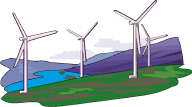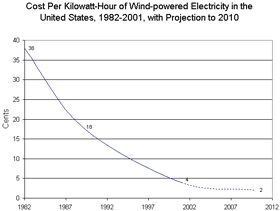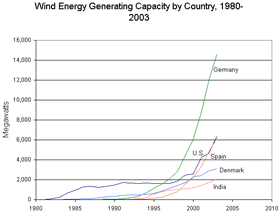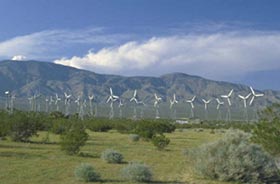|
If you're one of those people who every winter puts out 10,000 holiday lights or every summer keeps the air conditioning cold enough to make frozen treats on the kitchen counter—or whether you're like everyone else who simply likes the modern convenience of electrical power—then you should care about how we will generate electricity in the future.
We are in no danger of running out of coal, the primary fuel source for electricity generation in the US and many other parts of the world. And we could have as many new glowing nuclear power plants as we want. But the reality is that the pollution and safety impacts of these electricity-generating technologies forecast their necessary demise:
- The problems with coal-fired power plants include sulfur (acid rain) and mercury pollution; coal-fired power plants are the biggest source of greenhouse gases in the world; and coal mining scars land and people alike.
- Nuclear power plants are very clean in terms of emissions of typical pollutants, including carbon dioxide (the principal greenhouse gas), but the potential for accidents and terrorist strikes has most people doubting the wisdom of more nuclear power. And let's not forget that we still don't know what to do with the tons of long-term radioactive waste nuclear power plants produce.
|
So what does the future look like for electricity generation? We must start making major strides towards cleaner technologies like wind, solar, wave, and biomass. Today we talk about wind energy in an article that was adapted from materials made available by Lester Brown and the Earth Policy Institute.
~ ~ ~
THE BASICS OF WIND ENERGY
|
|
|
|
People have been harnessing the power of the wind for centuries. The concept of wind energy is simple: the wind pushes against angled blades, causing them to move (much like the sail on a boat); the blades are attached to a hub and cause it to turn, which in turn can drive other components.
In olden days—back when wind-powered devices were called windmills—the turning motion of the hub was transferred to mechanical devices such as grist mills or groundwater pumps.
 In a modern wind turbine, the hub drives an electrical generator and the output is electricity.
In a modern wind turbine, the hub drives an electrical generator and the output is electricity.
The modern wind turbine has come a long way in terms of sophistication, and the designs of today's wind turbines are elegant and very efficient compared to wind turbines from even a decade or two ago. Designers have also solved some problems associated with early wind turbines, such as birds dying by flying into them. Additional advancements have been made in siting technology—wind turbines can also be sited off-shore now.
WIND ENERGY AND COST
With wind-generated electricity, the principal production cost is the capital outlay for initial construction. Since wind is a free fuel, the only ongoing cost is for maintenance. Given the recent volatility of natural gas prices, the stability
 of wind power prices is particularly appealing. With the possibility of even higher costs of natural gas in the future, natural gas-fired plants may be used increasingly as backup for wind-generated electricity.
of wind power prices is particularly appealing. With the possibility of even higher costs of natural gas in the future, natural gas-fired plants may be used increasingly as backup for wind-generated electricity.
When the wind industry first began to develop in California in the early 1980s, wind-generated electricity cost 38¢ per kilowatt-hour. Since then it has dropped to 4¢ or less in prime wind sites. And some long-term supply contracts have been signed for 3¢ per kilowatt-hour. By 2020, many European wind farms will be generating electricity at 2¢ per kilowatt-hour, making it cheaper than all other sources of electricity.
Wind-generating capacity worldwide is growing at over 30% per year and has jumped from less than 5,000 megawatts in 1995 to 39,000 megawatts in 2003—an increase of nearly eight-fold. The fossil fuel with the highest growth rate—natural gas—grew at just over 2% annually during the same period. Oil grew at less than 2% annually, and coal at less than 1%. Nuclear generating capacity expanded by 2% annually.
AVAILABILITY OF WIND ENERGY IN THE U.S.
Wind is appealing for several reasons. It is abundant, cheap, inexhaustible, widely distributed, clean, and climate-benign—a set of attributes that no other energy source can match. When the US Department of Energy (DOE) released its first wind resource inventory in 1991, it pointed out that three wind-rich states—North Dakota, Kansas, and Texas—had enough harnessable wind energy to satisfy all of the nation's electricity needs. Those who had previously thought of wind as a marginal potential source of energy obviously were surprised by this finding.
|
In retrospect, we now know that the 1991 data was a gross underestimate of the potential of this renewable energy source, because it was based on the technologies available in 1991. Advances in wind turbine design since then have enabled turbines to operate at lower wind speeds, to convert wind into electricity more efficiently, and to harness a much larger wind regime. Such advancement have perhaps tripled the amount of harvestable wind. Thus, while the DOE could say in 1991 that North Dakota, Kansas, and Texas had enough wind-energy potential to supply all national ELECTRICITY needs, we may now be able to say that they have enough harnessable wind energy to supply all national ENERGY needs. (See sidebar for more information.)
|
FROM WIND POWER TO
HYDROGEN POWER |
|
Once we get cheap electricity from wind, we have the option of electrolyzing water to produce hydrogen, which provides a way of both storing and efficiently transporting wind energy. At night, when the demand for electricity drops, the hydrogen generators can be turned on to build up reserves.
Once in storage, hydrogen can be used to fuel power plants, in much the same way that natural gas is used. This hydrogen can be used either as a backup for wind power or as an alternative to natural gas, especially if rising prices make natural gas prohibitively costly for electricity generation.
Hydrogen is also the fuel of choice for the fuel-cell engines that automakers worldwide are working on for our everyday vehicles. While hydrogen-powered vehicles may still seem far off in the future, if push comes to shove on the climate front—i.e. once it becomes more obvious that we must stop burning so much oil and pumping so much CO2 into the atmosphere—cars with gasoline-burning internal combustion engines could be converted to hydrogen.
|
|
EUROPE IS LEADING THE WAY ON WIND ENERGY
Europe is leading the world into the age of wind energy, spurred in part by concerns about global warming. The record heat wave in
Europe in August 2003 that scorched crops and claimed 35,000 lives has accelerated the replacement of climate-disrupting coal with clean energy sources.
The European Wind Energy Association projects that Europe's wind-based electricity-generating capacity will nearly triple from 2003 to 2010. By 2020, wind-generated electricity is projected to satisfy
 the residential needs of 195 million Europeans—half of the region's population.
the residential needs of 195 million Europeans—half of the region's population.
After developing most of its existing 28,400 megawatts of capacity on land, Europe is now tapping offshore wind resources as well. A 2004 assessment of Europe's offshore wind-energy potential concluded that if Europe moves more aggressively to develop its vast offshore resources, wind could be supplying all of the region's residential electricity by 2020.
Many countries in Europe are pushing hard to bring in more wind power. Here are a few examples.
- The United Kingdom is requiring an investment of over $12 billion in off-shore wind farms that should satisfy the residential electricity needs of 10 million of the country's 60 million people.
- Tiny Denmark, which led Europe into the wind era with the development of its own wind resources, now gets an impressive 20 percent of its electricity from wind.
- Germany overtook the United States in terms of wind-based generating capacity in 1997. Now Spain is close to overtaking the United States as well.
Europe's leadership on wind energy has given it a major economic bonus: nine of the world's ten leading wind turbine manufacturers are in three countries—Denmark, Germany, and Spain. These happen to be the three countries that have had the strongest and most stable market incentives for developing wind energy.
WIND ENERGY IS LAGGING IN THE U.S.
In the US, wind power has grown 26% per year on average over the last 5 years, but the United States is lagging in the development of wind energy. This is not because we can't compete technologically with Europe in manufacturing wind turbines, but because of a lack of leadership in Washington. The wind production tax credit of 1.5¢ per kilowatt-hour, which was adopted in 1992 to establish parity with fossil-fuel subsidies, has been permitted to lapse three times in the last five years, most recently at the end of 2003 when Congress failed to pass a new energy bill. Such uncertainties disrupt planning throughout the wind power industry.
The United States, with its advanced technology and wealth of wind resources, should be a leader in this field, but unfortunately it continues
 to rely heavily on coal—a nineteenth century energy source—for much of its electricity at a time when European countries are replacing coal power with wind power.
to rely heavily on coal—a nineteenth century energy source—for much of its electricity at a time when European countries are replacing coal power with wind power.
Europe is not only leading the world into the wind age, it is also leading the world into the post-fossil fuel age—the age of renewable energy and climate stabilization. By demonstrating the potential for harnessing the energy in wind, Europe is unveiling the new energy economy for the rest of the world.
| Lester Brown is founder and president of Earth Policy Institute. He has been described by the Washington Post as "one of the world's most influential thinkers" and as "the guru of the global environmental movement" by The Telegraph of Calcutta. His most recent book is Plan B: Rescuing a Planet Under Stress and a Civilization in Trouble. |
|
~ ~ ~
|
One final note about wind power. There are naysayers out there who claim that we would have to blanket the country with "wind-meels" to replace all our coal and nuclear plants. Don't believe it. Remember that on a wind farm, the "footprint" of the operation—the turbine base plus the service roads—occupies only 5% of the land area. That makes wind power a perfect partner with open-space operations like farming and ranching.
And oh, by the way, our current electricity-generating technologies are blanketing the country with pollution!
|
|
BLOWING AROUND THE U.S. |
|
Good wind resources—which range from Class 3 to Class 7—have an average annual wind speed of at least 13 miles per hour. Such winds are found along the East Coast, the Appalachian Mountain chain, the Great Plains, the Pacific Northwest, and some other locations. North Dakota alone has enough energy from Class 4 and higher winds to supply 36% of the electricity of the lower 48 states.
|
|
Related articles on....
Resources for....
Get Grinning Planet free via email
|


